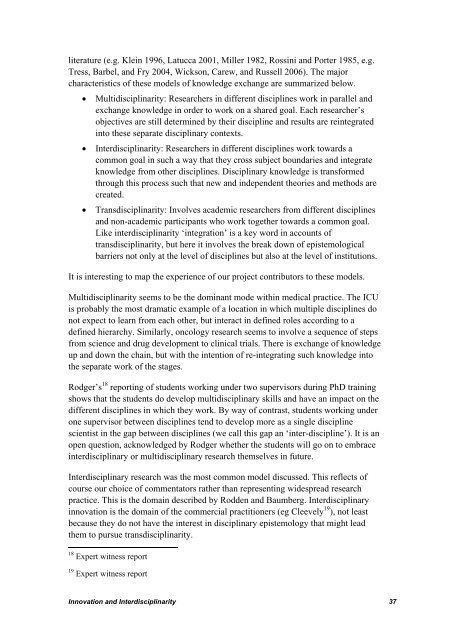Radical innovation: crossing knowledge boundaries with ...
Radical innovation: crossing knowledge boundaries with ...
Radical innovation: crossing knowledge boundaries with ...
You also want an ePaper? Increase the reach of your titles
YUMPU automatically turns print PDFs into web optimized ePapers that Google loves.
literature (e.g. Klein 1996, Latucca 2001, Miller 1982, Rossini and Porter 1985, e.g.<br />
Tress, Barbel, and Fry 2004, Wickson, Carew, and Russell 2006). The major<br />
characteristics of these models of <strong>knowledge</strong> exchange are summarized below.<br />
� Multidisciplinarity: Researchers in different disciplines work in parallel and<br />
exchange <strong>knowledge</strong> in order to work on a shared goal. Each researcher’s<br />
objectives are still determined by their discipline and results are reintegrated<br />
into these separate disciplinary contexts.<br />
� Interdisciplinarity: Researchers in different disciplines work towards a<br />
common goal in such a way that they cross subject <strong>boundaries</strong> and integrate<br />
<strong>knowledge</strong> from other disciplines. Disciplinary <strong>knowledge</strong> is transformed<br />
through this process such that new and independent theories and methods are<br />
created.<br />
� Transdisciplinarity: Involves academic researchers from different disciplines<br />
and non-academic participants who work together towards a common goal.<br />
Like interdisciplinarity ‘integration’ is a key word in accounts of<br />
transdisciplinarity, but here it involves the break down of epistemological<br />
barriers not only at the level of disciplines but also at the level of institutions.<br />
It is interesting to map the experience of our project contributors to these models.<br />
Multidisciplinarity seems to be the dominant mode <strong>with</strong>in medical practice. The ICU<br />
is probably the most dramatic example of a location in which multiple disciplines do<br />
not expect to learn from each other, but interact in defined roles according to a<br />
defined hierarchy. Similarly, oncology research seems to involve a sequence of steps<br />
from science and drug development to clinical trials. There is exchange of <strong>knowledge</strong><br />
up and down the chain, but <strong>with</strong> the intention of re-integrating such <strong>knowledge</strong> into<br />
the separate work of the stages.<br />
Rodger’s 18 reporting of students working under two supervisors during PhD training<br />
shows that the students do develop multidisciplinary skills and have an impact on the<br />
different disciplines in which they work. By way of contrast, students working under<br />
one supervisor between disciplines tend to develop more as a single discipline<br />
scientist in the gap between disciplines (we call this gap an ‘inter-discipline’). It is an<br />
open question, ac<strong>knowledge</strong>d by Rodger whether the students will go on to embrace<br />
interdisciplinary or multidisciplinary research themselves in future.<br />
Interdisciplinary research was the most common model discussed. This reflects of<br />
course our choice of commentators rather than representing widespread research<br />
practice. This is the domain described by Rodden and Baumberg. Interdisciplinary<br />
<strong>innovation</strong> is the domain of the commercial practitioners (eg Cleevely 19 ), not least<br />
because they do not have the interest in disciplinary epistemology that might lead<br />
them to pursue transdisciplinarity.<br />
18 Expert witness report<br />
19 Expert witness report<br />
Innovation and Interdisciplinarity 37

















